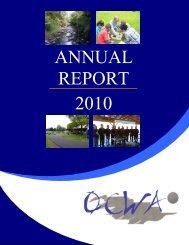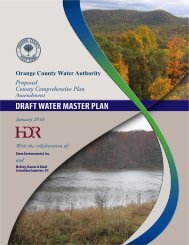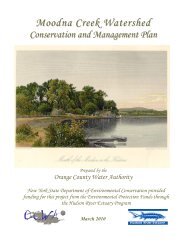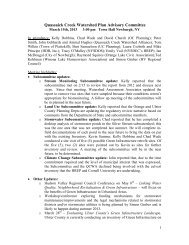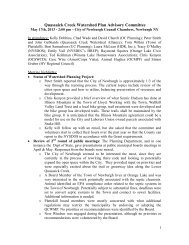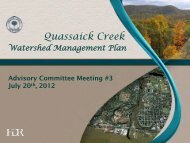Biodiversity of the Moodna Creek Watershed - Orange County Water ...
Biodiversity of the Moodna Creek Watershed - Orange County Water ...
Biodiversity of the Moodna Creek Watershed - Orange County Water ...
Create successful ePaper yourself
Turn your PDF publications into a flip-book with our unique Google optimized e-Paper software.
<strong>Moodna</strong> <strong>Biodiversity</strong><br />
L. Heady, 19 June 2008 DRAFT<br />
The following recommendations for landscape connections incorporate suggestions included in<br />
<strong>the</strong> <strong>Orange</strong> <strong>County</strong> Open Space Plan (Figure 5):<br />
• Goosepond Mountain to Sterling Forest<br />
• Goosepond Mountain to Schunnemunk Mountain<br />
• Schunnemunk Mountain to Stewart State Forest<br />
• Schunnemunk Mountain to Storm King<br />
• Black Meadow Reservoir to Purgatory Swamp<br />
• Otter Kill/<strong>Moodna</strong> <strong>Creek</strong> corridor (linear along river)<br />
• Stream corridors throughout <strong>the</strong> watershed.<br />
Land cover and fragmenting features in <strong>the</strong>se potential connections will need to be assessed to<br />
determine feasibility for establishing functional biodiversity corridors. In addition to<br />
maintaining existing connections, <strong>the</strong>re may be opportunities to restore linkages severed by<br />
major roadways, dams, and o<strong>the</strong>r barriers. Academic institutions, graduate students,<br />
conservation organizations, and <strong>the</strong> Hudson River Estuary Program may serve as good partners<br />
for conducting such analyses. Subsequent steps may require intermunicipal partnerships,<br />
outreach to landowners, coordination with land trusts, and planning tools such as conservation<br />
overlay zones, critical environmental areas, and conservation subdivision guidelines.<br />
Establishment <strong>of</strong> a biodiversity network does not necessitate outright purchase and protection <strong>of</strong><br />
all lands, but it does require careful planning and innovative designs to maintain a permeable<br />
landscape, where wildlife does not perish due to vehicular traffic, lawnmowers, stormdrain<br />
pitfalls, household pets, and impassable barriers.<br />
While habitat connections at <strong>the</strong> regional scale are very important, finer-scale assessment <strong>of</strong> <strong>the</strong><br />
watershed is needed to identify <strong>the</strong> importance <strong>of</strong> local-scale connections; e.g., forested<br />
connectivity between clusters <strong>of</strong> woodland pools, or connections between core wetlands and<br />
upland overwintering habitats used by nor<strong>the</strong>rn cricket frog. Because <strong>the</strong>y provide important<br />
landscape links, stream corridors should be analyzed to evaluate <strong>the</strong> condition <strong>of</strong> riparian buffers<br />
and identify opportunities for restoration or conservation. (See Figure 3.)<br />
Threats and Conservation Opportunities<br />
• Data gaps. More information is needed to build a strong smart growth plan for <strong>the</strong><br />
watershed, which preserves cores and connections for biodiversity, while adequately<br />
addressing <strong>the</strong> needs for future growth <strong>of</strong> human communities. The <strong>Orange</strong> <strong>County</strong><br />
<strong><strong>Water</strong>shed</strong> Authority may want to convene an advisory committee to identify priority<br />
data gaps, pursue fur<strong>the</strong>r studies, and refine recommendations to implement a plan for<br />
conserving <strong>Moodna</strong>’s conservation network.<br />
• Updates to <strong>County</strong> plans. <strong>Orange</strong> <strong>County</strong>’s “Priority Growth Areas,” which suggest<br />
future population growth centers, contradict <strong>the</strong> recommendations set forth in <strong>the</strong> <strong>Orange</strong><br />
<strong>County</strong> Open Space Plan for biodiversity cores and connections. For example, a priority<br />
growth area is projected for <strong>the</strong> area between Goosepond and Schunnemunk Mountains,<br />
but this same area was identified as an important corridor in <strong>the</strong> open space plan. These<br />
discrepancies should be resolved or compatible priorities should be established to<br />
accommodate future development in appropriate areas. The upcoming update <strong>of</strong> <strong>the</strong><br />
county comprehensive plan presents an excellent opportunity to reevaluate <strong>the</strong>se<br />
recommendations.<br />
25



